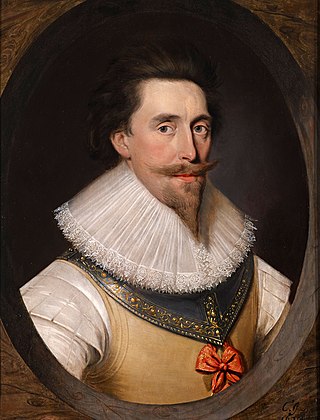
Sir Walter Mildmay was a statesman who served as Chancellor of the Exchequer to Queen Elizabeth I, and founded Emmanuel College, Cambridge.

Thorpe Mandeville is a village and civil parish in West Northamptonshire, England about 6 miles (10 km) northeast of Banbury in neighbouring Oxfordshire. The hamlet of Lower Thorpe is just north of the village.

Barnwell is a village in North Northamptonshire in England, 2 miles (3.2 km) south of the town of Oundle, 78 miles (126 km) north of London and 14 miles (22.5 km) south-west of Peterborough. The River Nene runs north of the village, separating it from Oundle.

Sulgrave is a village and civil parish in West Northamptonshire, England, about 5 miles (8 km) north of Brackley. The village is just south of a stream that rises in the parish and flows east to join the River Tove, a tributary of the Great Ouse.

Ambrosden is a village and civil parish in Cherwell, Oxfordshire, England, 3 miles (5 km) southwest of Bicester to which it is linked by the A41 road, and 13 miles (21 km) from Oxford. The 2011 Census recorded the parish's population as 2,248. The parish is bounded by the River Ray to the south, its tributary the River Bure to the west, the outskirts of Bicester to the north and field boundaries to the east.

Ashley is a village and civil parish in North Northamptonshire, England, about 4 miles (6.4 km) northeast of Market Harborough, Leicestershire and 5 miles (8.0 km) west of Corby. The population of the civil parish at the 2011 Census was 224, an increase from 217 at the 2001 Census. The village is near the River Welland, which forms the border with Leicestershire. The Roman road called Via Devana in the part from Ratae to Duroliponte ran just north of the village.

King's Cliffe is a village and civil parish on Willow Brook, a tributary of the River Nene, about 9 miles (14 km) northeast of Corby in North Northamptonshire. The parish adjoins the county boundary with the City of Peterborough and the village is about 12 miles (19 km) west of the city centre. The village is not far from the Northamptonshire boundaries with both Cambridgeshire and Lincolnshire, and is about 6 miles (10 km) south of Stamford.

Hinton-in-the-Hedges is a small village and civil parish in West Northamptonshire, England, two miles due west of the town of Brackley. West of the village is Hinton-in-the-Hedges Airfield. At the time of the 2001 census, the parish's population was 179 people. It had decreased to 167 at the 2011 Census.

Francis Fane, 1st Earl of Westmorland, of Mereworth in Kent and of Apethorpe in Northamptonshire was an English landowner and politician who sat in the House of Commons between 1601 and 1624 and then was raised to the Peerage as Earl of Westmorland.

Mildmay Fane, 2nd Earl of Westmorland, styled Lord le Despenser between 1624 and 1628, was an English nobleman, politician and writer.

Apethorpe Palace, formerly known as "Apethorpe Hall", is a Grade I listed country house, dating to the 15th century, close to Apethorpe, Northamptonshire. It was a "favourite royal residence" for James I.

Fishbourne is a village and civil parish in the Chichester District of West Sussex, England and is situated two miles (3.2 km) west of Chichester.

Seend is a village and civil parish about 3 miles (5 km) southeast of the market town of Melksham, Wiltshire, England. It lies about 3.5 miles (6 km) west of Devizes and 5.5 miles (9 km) northeast of the county town of Trowbridge. The parish includes the sub-village of Seend Cleeve and the hamlets of Inmarsh, Martinslade, Seend Head, Sells Green and The Stocks.

East Carlton is a village and civil parish in the county of Northamptonshire, on the southern ridge overlooking the Welland valley to the north and covers 1,645 acres (666 ha) on a long strip of land. It is 2 miles (3.2 km) west of the town of Corby and is administered as part of North Northamptonshire but was previously in the Corby borough until 2021. At the time of the 2001 census, the parish's population was 270, reducing to 259 at the 2011 census. East Carlton is one of the Thankful Villages that suffered no fatalities during World War I.

Charles Fane, 3rd Earl of Westmorland, styled Lord le Despenser between 1626 and 1666, of Apethorpe Hall, Northamptonshire was a British peer and twice Member of Parliament for Peterborough.

Sir Anthony Mildmay of Apethorpe Palace, Northamptonshire, served as a Member of Parliament for Wiltshire from 1584 to 1586 and as English ambassador in Paris in 1597.

St Leonard's Church is an Anglican church in the village of Apethorpe in Northamptonshire, England. It is an active parish church in the Diocese of Peterborough. It has been designated a Grade I listed building by English Heritage.
Grace, Lady Mildmay was an English noblewoman, memoirist and medical practitioner. Her autobiography is one of the earliest existing autobiographies of an English woman. Originally from Wiltshire, she married Sir Anthony Mildmay in 1567 and moved to Apethorpe Palace, his father's home in Northamptonshire. She practised medicine on her family and others, with an extensive knowledge of medical theory, and a large repertoire of cures. Her writings included memoirs, medical papers and devotional meditations.

Rachel Bourchier, Countess of Bath, wife of Henry Bourchier, 5th Earl of Bath (1587-1654), was an English noblewoman and writer, best known for her activities during the English Civil War.

Edward Browning was an English architect working in Stamford.





















